The Ultimate Guide to Diabetes Friendly Grocery Shopping to Reduce High Blood Sugars
Reviewed by: Dr. T S Deepthi Sarojini | Author: Manoja Kalakanti
Have you been recently diagnosed with diabetes and confused about the new dietary restrictions? Is the new reality setting in, that life as you know it will never be the same again? It’s understandable; maybe you are a foodie who likes to enjoy life’s little pleasures. A sugary treat to celebrate a special occasion or a bucket of buttery popcorn while you enjoy your favourite shows on Netflix. And now here you stand, with a list in hand that seems restrictive and plain boring! Don’t worry! Here’s a diabetic meal plan with a diabetic grocery list to make your diabetes-friendly grocery shopping more exciting.
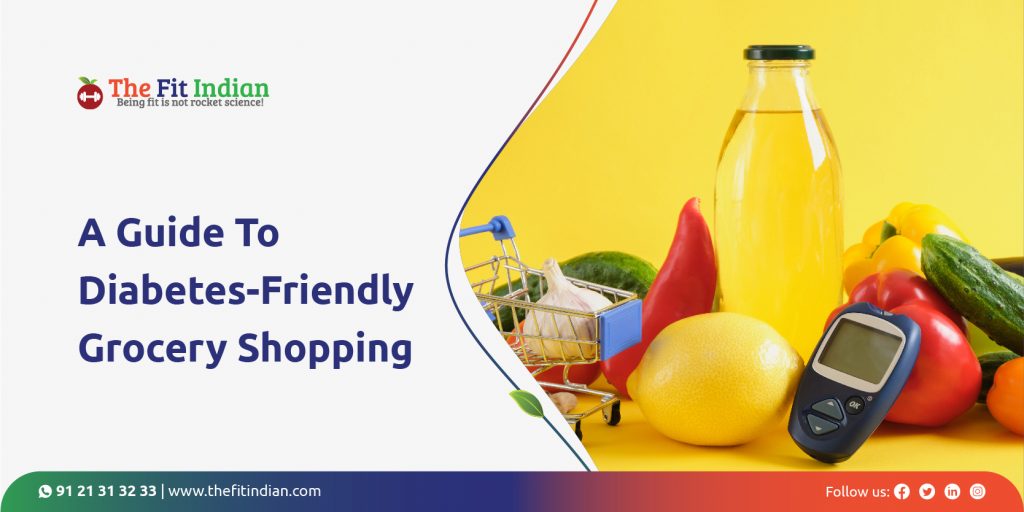
You can still enjoy many of the delicious foods and drinks. And remember, this list and meal plan can help you manage diabetes and prevent its consequences. Still not sure why a person with diabetes needs to go grocery shopping armed with a list in hand? Keep reading to find out!
Why you Need a Diabetic Meal Plan with a Grocery List
Eating a healthy diet is crucial for everyone, especially those with diabetes. The food we eat, the amount, and how we eat it has a huge impact on our overall health. The primary goal of someone with diabetes is to keep the blood sugar levels in check. To accomplish this, the individual may have to:
- Ensure that they consume food in moderation
- Eat at regular intervals, preferably every 3-4 hours
- Keep calorie intake in mind with portion control
- Consume low glycemic index foods
- Find healthier alternatives for unhealthy foods
- Keep an eye on carbohydrate intake since they have the highest impact on blood sugar levels
- Follow the Diabetes Plate Method – Filling half your plate with vegetables (non-starchy), a quarter with lean protein, and the other quarter with carbohydrates. You can include healthy fats
- Consult with a nutritionist or a dietician to help you prepare a healthy meal plan
But without proper planning or knowledge about the foods to eat and avoid, your diabetes management plan will be in disarray. And not controlling the condition may lead to severe health risks.
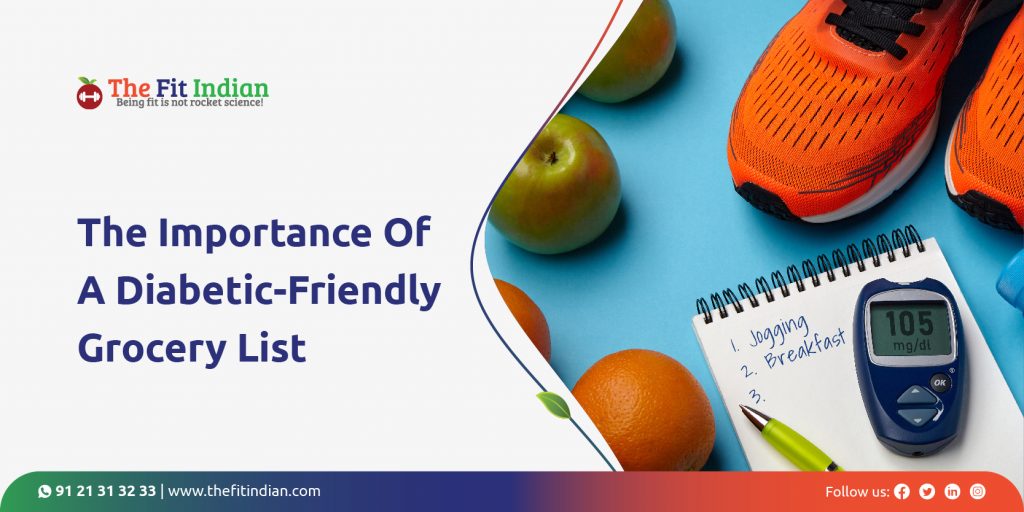
Unlike a person without diabetes, someone with the condition cannot randomly eat whatever they fancy. They must get the right amount of nutrition without quickly raising their blood sugar levels. This requires proper planning.
A proper diabetic meal plan with a grocery list can provide all the nutritional needs while keeping the blood sugar levels in check. This will also keep other diabetes-related illnesses such as heart diseases and hypertension at bay.
Let’s now look at the perfect diabetes-friendly diabetes shopping list to help you be shop right.
A Diabetes-Friendly Grocery List and Tips to Shop Smartly
A pre-diabetic grocery list or one for people who have been diagnosed with the condition focuses on a healthy diet that keeps the blood sugar levels under control. This list will help you prepare the next time you go out grocery shopping.
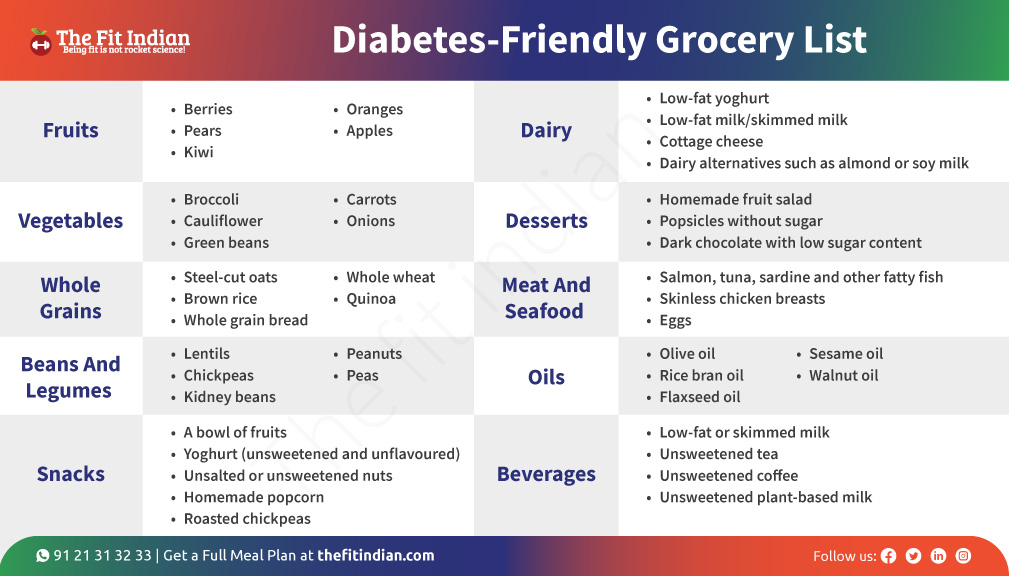
Follow this type 2 diabetes grocery list to manage the condition successfully.
1. Fruits
Fruits are a healthy and delicious choice for people with diabetes to savour. They provide vital nutrients that can boost a person’s overall health with diabetes. But not all fruits are a good choice for people with this condition. Fruits have sugar in them; hence you must choose the ones low on the glycemic index, such as:
- Berries
- Pears
- Kiwi
- Oranges
- Apples
2. Vegetables
Vegetables should be a part of any healthy diet, including a diabetes-friendly diet. They are a reservoir of nutrients. Non-starchy vegetables that are low in calories and carbohydrates should be selected. They are absorbed slowly into the bloodstream, preventing a sudden spike in blood sugar levels. Choose vegetables such as:
- Broccoli
- Cauliflower
- Green beans
- Carrots
- Onions
3. Whole Grains
Grains, even if whole, can be bad for a person with diabetes if consumed in excess.
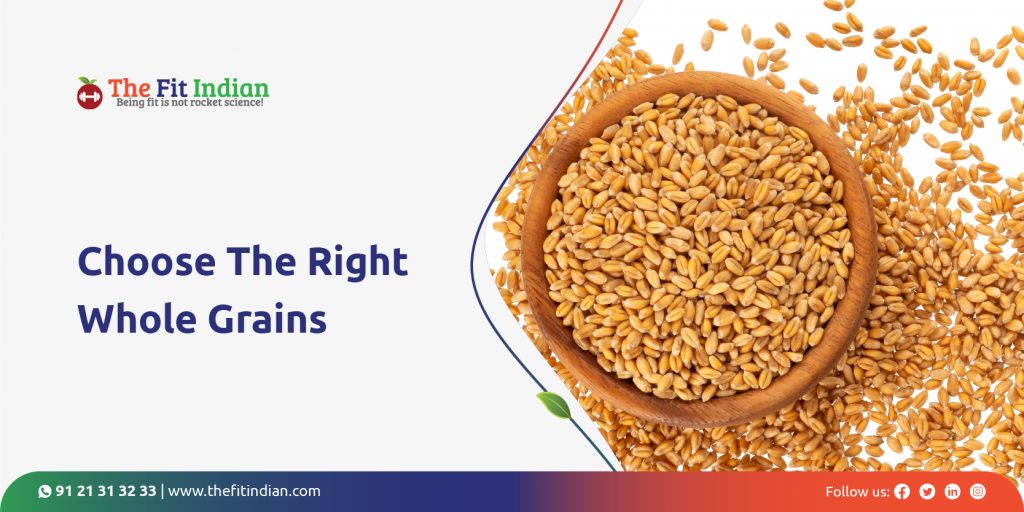
They can cause a spike in blood sugar levels. But they are always better than refined grains. Choose grains such as:
- Steel-cut oats
- Brown rice
- Whole grain bread
- Whole wheat
- Quinoa
4. Beans and Legumes
Beans and legumes are good sources of protein and fibre. The rich fibre makes them a better and healthier alternative to other carbs. Here are some examples:
- Lentils
- Chickpeas
- Kidney beans
- Peanuts
- Peas
5. Snacks
We all crave the occasional snacks. But most of the snacks available in the market are unhealthy and not diabetes-friendly. So, if you have diabetes and crave some snacks, you can go for:
- A bowl of fruits
- Yoghurt (unsweetened and unflavoured)
- Unsalted or unsweetened nuts
- Homemade popcorn
- Roasted chickpeas
6. Dairy
Dairy products contain calcium, protein and other essential nutrients. But many dairy products are high in fats. So, go for the following dairy products:
- Low-fat yoghurt
- Low-fat milk/skimmed milk
- Cottage cheese
- Dairy alternatives such as almond or soy milk
7. Desserts
Keeping away from desserts can be a hard pill to swallow for people with diabetes.
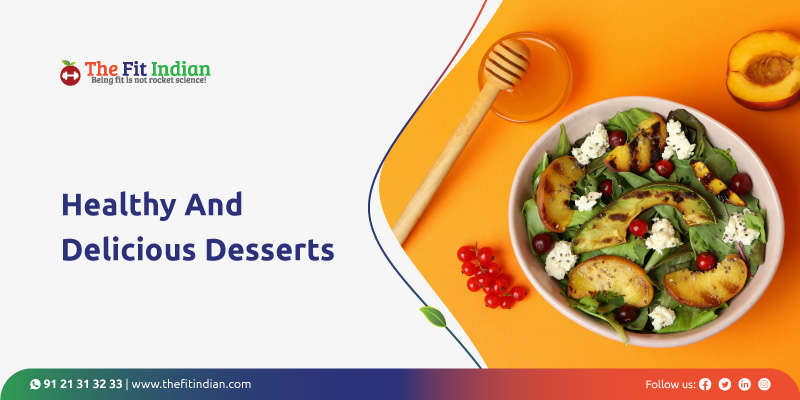
But the good news is that you don’t have to avoid it entirely. You can have the following diabetes-friendly desserts:
- Homemade fruit salad
- Popsicles without sugar
- Dark chocolate with low sugar content
8. Meat and Seafood
Meat and seafood are rich in protein, which is good for people with diabetes. Fishes are one of the best foods for optimal health. It is also a good choice for people with diabetes. Meat is also a rich source of protein. But you must avoid fatty meats. Try the following:
- Salmon, tuna, sardine and other fatty fish
- Skinless chicken breasts
- Eggs
9. Oils
Not all fats or oils are bad for health. Many fats and oils offer health benefits, including effective diabetes management.
- Olive oil
- Rice bran oil
- Flaxseed oil
- Sesame oil
- Walnut oil
10. Beverages
The best drink for people with diabetes is water. But if you fancy something flavourful, you need to pick the right drink.
- Low-fat or skimmed milk
- Unsweetened tea
- Unsweetened coffee
- Unsweetened plant-based milk
Consult your doctor for guidance in creating a gestational diabetes shopping list. Gestational diabetes can be very challenging and requires medical professionals’ advice. Below are some essential tips to help you with your diabetes-friendly shopping.
Important Grocery-Shopping Tips to Follow
But just knowing what you must buy won’t suffice. You need to follow some guidelines to religiously follow the habit and be accustomed to the new routine.
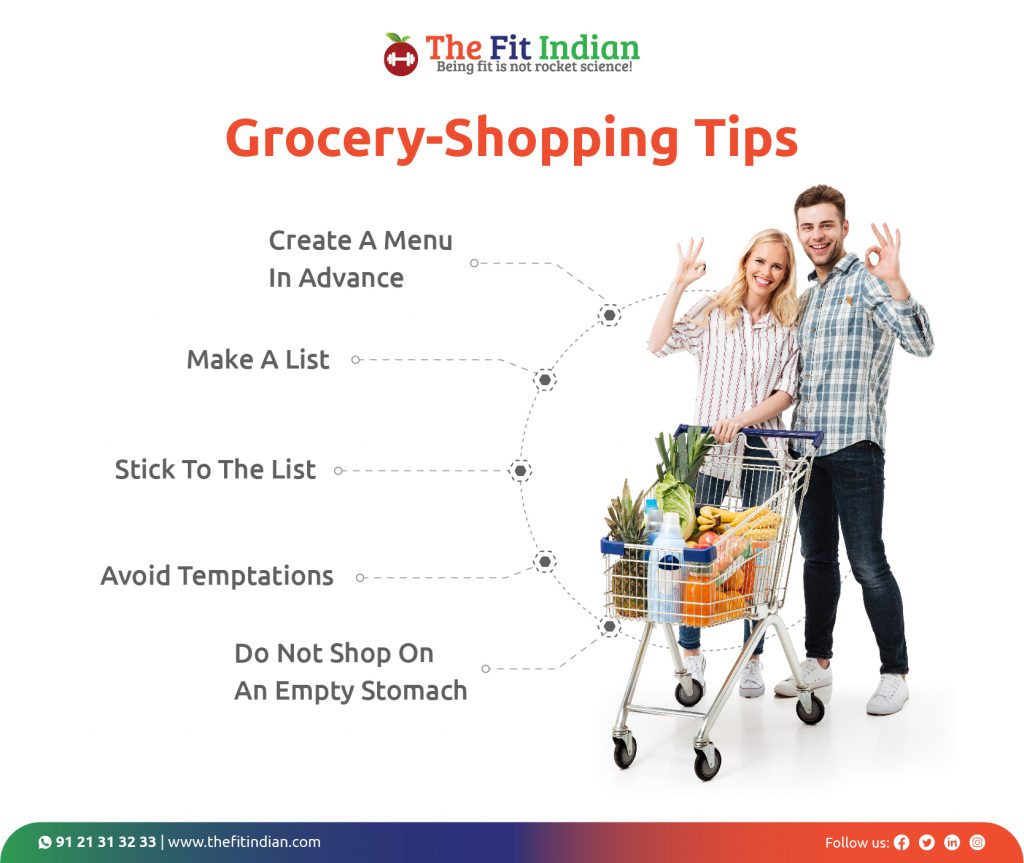
So, here are some grocery shopping tips for people with diabetes:
1. Create a menu in advance
Create an entire week’s meal plan in advance. This will help you create goals and stick to them. You can also keep track of your calorie intake. It also allows you to steer clear of impulse buying. Get the help of a dietician or a nutritionist to prepare a customized diet plan.
2. Make a list
Now that you have planned out your meals, you need the ingredients. So, when you go grocery shopping, you know precisely what to buy.
3. Stick to it and make it a routine
You have to make this a habit to control diabetes. Follow the routine for a couple of weeks until it becomes a habit.
4. Avoid temptations – Find replacements
While shopping for groceries, it is easy to be tempted by unhealthy snacks and beverages. To overcome this temptation, find a healthy replacement for whatever you crave. Go for skimmed milk instead of whole milk or whole fruit instead of fruit juice.
5. Avoid shopping on an empty stomach
Never shop on an empty stomach! If you are hungry while grocery shopping, you might end up buying all sorts of unhealthy fried, high-fat and sugary foods.
By now, you are aware of the foods to choose when out on diabetic-friendly grocery shopping. But what are the foods that you must avoid? Let’s find out!
Foods and Drinks to Avoid While Grocery-Shopping
You are now armed with a diabetes-friendly grocery list, but what about the foods that you must avoid? It may seem an uphill challenge to avoid the long line of delicious but unhealthy foods, and beverages lined up the aisles of a supermarket. But avoid you must! It is very easy to fall for the myriad temptations that accompany you on a grocery shopping trip.
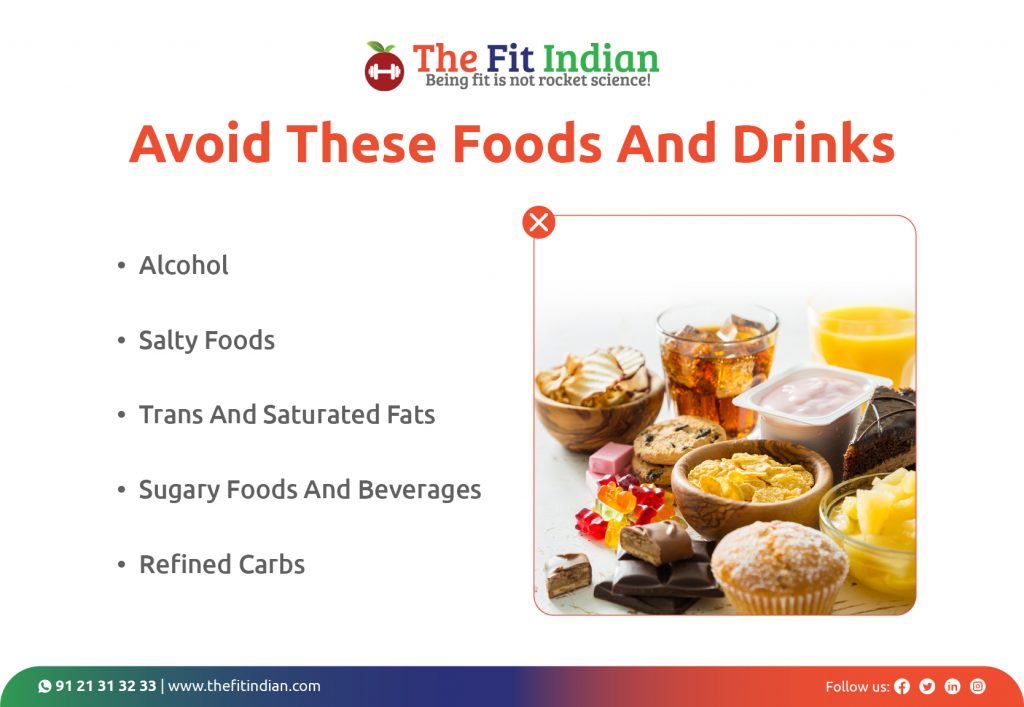
The list of foods to avoid while shopping is just as critical as the best grocery list for diabetics. Steer clear of the following foods:
1. Alcohol
Alcohol can cause dangerous fluctuations in your blood sugar levels. It is not so unhealthy when consumed in moderation. But regular or excessive consumption can have adverse consequences. Either way, it’s best to avoid alcohol if you have diabetes.
2. Salty foods
It’s hard to resist the addictive salty snacks, but you should avoid consuming them. Check the label to see salt content before purchasing a product.
3. Trans and saturated fats
These fats can result in insulin resistance and inflammation. They are commonly found in frozen foods, butter, cheese, cakes, cookies and fried foods.
4. Sugary Foods and beverages
Sugary foods and beverages can cause insulin resistance and disturb the metabolic rate. They can also increase the risk of diabetes-related diseases.
5. Refined carbs
Refined foods can cause a quick rise in your blood sugar levels and must be limited. They include white rice, white bread, and white flour.
There is another critical thing to keep in mind while shopping. Always check the labels when buying packaged foods.
The Importance of Checking Labels
One thing that can undermine your efforts at controlling diabetes are packaged foods. Many of these packaged come with tall claims of being healthy and natural. But most of them are far from being healthy.
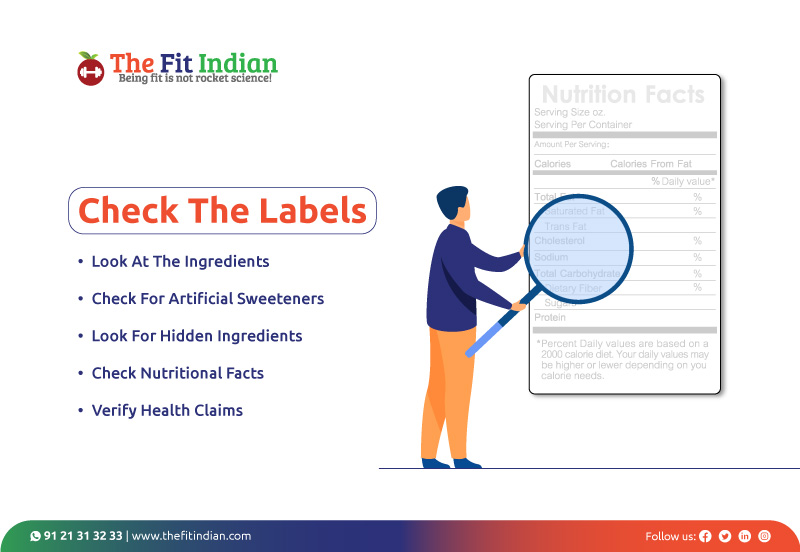
One wrong purchase, and you might end up consuming a lot of calories and other harmful ingredients. It is also important to check the labels to ensure it is diabetes-friendly.
Look out for the following information when buying a packaged product:
1. Look at the ingredients
Check the ingredient to ensure that it won’t quickly raise your blood sugar levels. The ingredient list is compiled of the highest content to the lowest. Also, the least ingredients there are in a product, the healthier it should be.
2. Check for artificial sweeteners
The sugar-free claim may make a product sound healthy, but that’s far from the truth. Yes, no sugar is good news for people with diabetes. But the artificial sweeteners are also not as healthy as they claim. So, limit or avoid artificial sweeteners.
3. Look for hidden ingredients
Many ingredients are mentioned by names that you may not recognize easily. Preservatives, sugar as dextrose or fructose,
and trans and saturated fats can be hidden inside the long list of ingredients.
4. Check nutritional facts
The long list of nutritional facts on a label may seem confusing. Carefully check the amount of carbohydrates, calories and the complete nutritional profile.
5. Verify health claims and certifications
Most packaged products make large claims that are often not true. Even if not entirely false, many of these claims can be exaggerated. They may claim to contain zero fat or sugar or all-natural. Check the label properly to ascertain if the claims are true.
Below is a diet plan that includes healthy foods to help you manage diabetes.
Diet Plan
Having a meal plan prepared in advance is the first step towards controlling diabetes through dietary modifications. Once you have a diet plan in hand, you can prepare a grocery shopping list. This list can consist of the ingredients required for your diet plan.
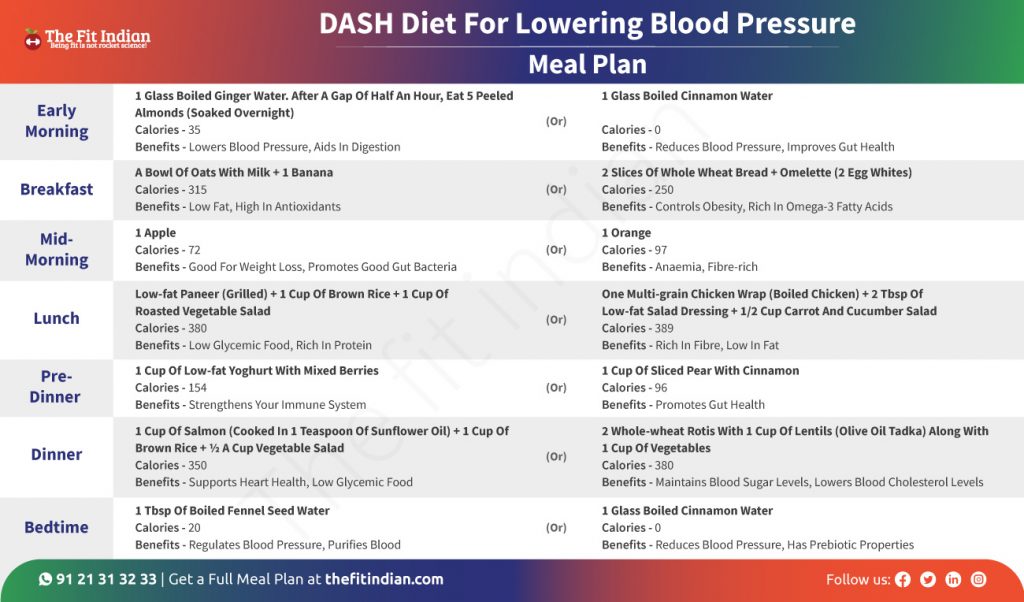
A diabetic meal plan with a grocery list will make your grocery shopping easier and prevent you from buying anything unhealthy. For a customized diet plan, consult a dietician or a nutritionist.
Bottomline
A healthy diet is just one aspect of managing diabetes, albeit the most vital tool. To effectively control the condition, one must combine a good diet with regular physical activity. You must also regularly monitor your blood sugar levels. While dietary modifications may seem like a daunting task initially, you will get accustomed to the change. You can also consult your doctor or a nutritionist to guide you to prepare the ideal diet. A grocery shopping list can be the difference between controlled and uncontrolled diabetes.
FAQ’s
1. What can diabetics eat?
People with diabetes should aim for foods low on the glycemic index. These foods are usually rich in fibre and complex carbohydrates. They may include – most vegetables, fruits with a low glycemic index, whole grains and low-fat dairy and fish.
2. What groceries should a diabetic buy?
A person with diabetes needs to make wise choices while shopping for groceries. They can buy foods such as:
- Fresh vegetables
- Fruits (with low glycemic index)
- Whole grains
- Legumes
- Lean meat
- Fish
- Nuts and seeds
- Low-fat dairy
3. What kind of fats can you eat if you have diabetes?
You must eat healthy fats such as monounsaturated fats and polyunsaturated fats. Foods rich in these fats include nuts, avocado, olive oil, peanut butter, fish and flax seeds.
4. What should a diabetic have on their shopping list?
A person with diabetes must shop for low glycemic index foods and beverages that do not spike blood sugar levels. These foods are high in fibre content and complex carbohydrate.
5. What foods are good for type 2 diabetes?
The following foods are considered to be good for type 2 diabetes.
- Healthy fats such as olive oil, nuts, seeds and avocado
- Whole grains such as whole wheat, oats and brown rice
- Fruits that are rich in fibre and low n sugar content
- Fresh vegetables
6. What foods are good for prediabetes to eat?
Some of the best foods for those who are prediabetes include:
- Steel-cut oats
- Beans
- Vegetables
- Fish
- Sweet potatoes
- Corn
- Whole wheat bread
7. What foods to eat with high blood pressure and diabetes?
Foods that help manage high blood pressure and diabetes are as follows:
- Vegetables
- Fruits
- Whole grains
- Lean meat
- Low-fat dairy products
- Nuts
- Seeds
8. What fruits can diabetics eat?
People with diabetes can eat low glycemic index fruits such as:
- Berries
- Apples
- Oranges
- Kiwis
- Peaches
9. What foods should you not eat if you are diabetic?
People with diabetes must avoid foods or drinks that have a high glycemic index score and raise the blood sugar levels such as:
- Sugary foods or beverages
- Processed foods such as white rice, white bread and pasta
- Dry fruits
- Fried foods
- Foods high in saturated and trans fats
- Packaged foods
- Fruit juices
10. What are the 5 worst foods for diabetics?
The 5 worst foods for people with diabetes are:
- Sweetened breakfast cereals
- Dried fruits
- Trans fats
- Refined carbs
- Sugary beverages




Manoja Kalakanti